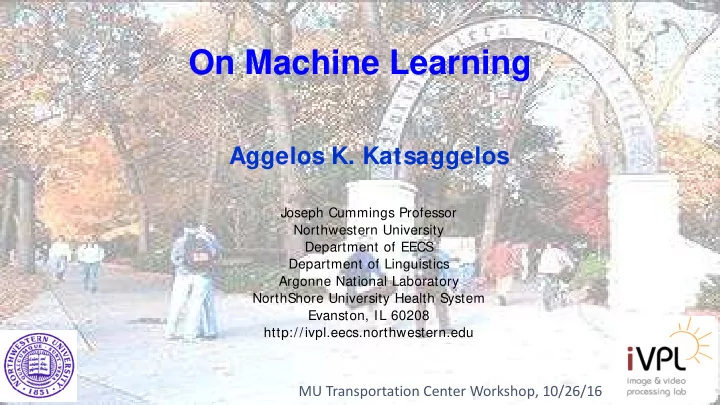

On Machine Learning Aggelos K. Katsaggelos Joseph Cummings Professor Northwestern University Department of EECS Department of Linguistics Argonne National Laboratory NorthShore University Health System Evanston, IL 60208 http://ivpl.eecs.northwestern.edu MU Transportation Center Workshop, 10/26/16
What is Machine Learning • A machine learning algorithm is an algorithm that is able to learn from data • But what do we mean by learning? • “A computer program is said to learn from experience E with respect to some class of tasks T and performance measure P , if its performance at tasks in T , as measured by P, improves with experience E.” (Mitchell 1997)
Task • ML allows us to tackle tasks that are too difficult to solve with fixed programs written and designed by human beings – From a scientific and philosophical point of view, ML is interesting because developing our understanding of ML entails developing our understanding of the principles that underlie intelligence • ML tasks are usually described in terms of how the machine learning system should process an example
Common ML Task • Classification • Classification with missing inputs • Regression • Transcription (optical character recognition, speech processing) • Structured outputs (any task where the output exhibits important relationships between the different elements, e.g. parsing a natural language segment, image segmentation, image captioning)
Common ML Task • Anomaly detection (fraud detection; profile of user is build and used) • Synthesis and Sampling (text to speech, video games: automatically generate textures for large objects) • Imputation of missing values • Denoising • Density (or prob mass function) estimation
The Performance Measure • Usually specific to the task T • E.g. Classification – Accuracy (proportion of correct output) – Similarly: error rate (expected 0-1 loss) • E.g. Density Estimation – Ave log probability the model assigns to some examples • E.g. Transcription – Accuracy at transcribing entire sequences – Or more fine grained performance, e.g. partial credit for getting some words right • E.g. Regression – should we penalize the system more if it frequently makes medium-sized mistakes or if it rarely makes very large mistakes?
The Experience E • Machine learning algorithms can be broadly categorized as • unsupervised • supervised • semi-supervised • reinforcement learning algorithms
Is it a cat or a dog? vs vs.
1. Gather data
2. Extract features (what distinguishes a cat from a dog?) - cats have small noses and pointy ears - dogs have big noses and round ears
The feature space each creature is now represented by two numbers: (nose size, ear shape)
3. Train the model (find best parameters via numerical optimization)
5. Test the model (on new data)
Meanwhile in the feature space...
Classification Pipeline
Application Areas • Regression, Classification, Dimensionality Reduction • Financial modeling, weather forecasting, genetics • Face/pedestrian/object detection, hand gesture recognition, speech recognition, optical character recognition, gender classification, sentiment analysis, spam detection • Econometrics • Neuroscience • Driver-assisted and autonomous cars • Recommendation systems
What is ML commonly used for today? • Target advertising : recommend advertisements and products to users based on some understanding of their tastes, their consumption history, how they think, etc.,
ML a member of a bigger family • Applied Statistics • Operations Research • Natural Language Processing • Signal Processing • Pattern Recognition • Computer Vision • Image Processing • Speech Processing
Bigger Picture • Big Data Analytics – Understanding the past: ( descriptive analytics = what happened; diagnostic analytics = why did it happen) – Projecting the future: predictive analytics = what will happen – Seeing and improving future: prescriptive analytics = what will happen, when, why, and how to make the most out of this predicted future
Recommend
More recommend